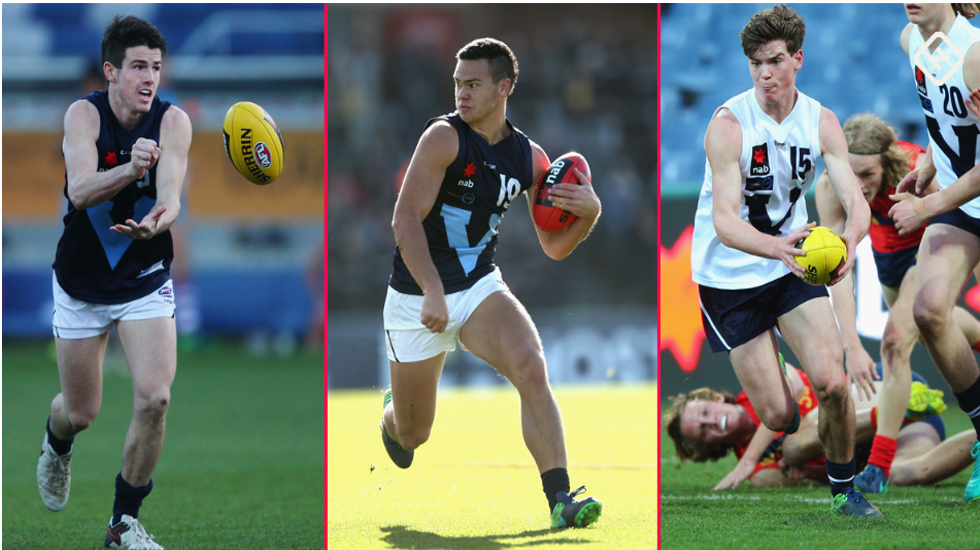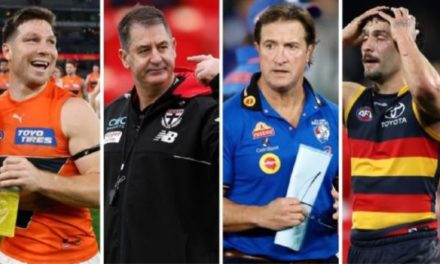(Left to right): Andrew Brayshaw, Cameron Rayner and Paddy Dow. Any of them could be the first player picked in this year’s draft. Photos: GETTY IMAGES
In this year’s AFL draft, it’s just a number not a sentence
The AFL national draft is on Friday, and experienced recruiters are having trouble recalling another when the possible order of selections was as open as seems this year’s version.
There’s the usual quality at the top end, a clutch of impressive youngsters who have starred in junior ranks. But not nearly so much agreement about just which kid will end up at which club.
Brisbane has the first pick, but there’s up to half-a-dozen players the Lions may elect to take, the likes of the highly-rated Cameron Rayner, Paddy Dow, Andrew Brayshaw, Adam Cerra and Luke Davies-Uniacke all potentially beginning their AFL careers at the Gabba.
That uncertainty by consequence extends to the clubs whose picks follow Brisbane’s – Fremantle, Carlton and North Melbourne, before the Dockers have a second crack, then Collingwood, before St Kilda has two picks in a row.
All of them will doubtless end up with pretty good players, but, given the range of possibilities, without perhaps the amount of hype we’ve often seen attached to a No.1 pick over the years.
And there’s no question about the biggest winner in that scenario. It’s the players themselves, who will get to take their first steps in senior football far less shackled by a ridiculous amount of expectation. That in itself must make someone like Jack Watts smile ruefully.
The juxtaposition of the more realistic view of this year’s draft crop with what Watts had to endure is impossible to ignore now that the former Demon, the No.1 selection in the 2008 draft, is about to re-invent himself at Port Adelaide after nearly a decade of disappointing those at Melbourne who expected him to become an instant messiah.
To say Watts was thrown to the wolves back then would be an understatement. Selected No.1 in a blaze of publicity, the talented but raw and physically underdone 18-year-old was wheeled out for his first senior game amidst much fanfare in a huge Queen’s Birthday clash against Collingwood in 2009 in front of more than 60,000 at the MCG.
The teenager was immediately and conspicuously targeted by the Magpies, memorably set upon by three opponents the first time he went near the ball. It was Christians thrown to the Lions stuff, and some would argue a shock to the system from which Watts never really recovered.
No moment has better highlighted the deep end into which AFL draftees were regularly thrown back then. Here was a spindly kid, one of just 22 players in the competition’s bottom team and without the necessary experience or conditioning, somehow expected on his own to revive an entire football club’s ailing fortunes.
Watts was the most glaring example. But his successor as No.1 draft pick, teammate Tom Scully, went through a similarly harsh judging process at Melbourne before becoming an instant villain to the Demons by defecting for dollars to Greater Western Sydney.
It’s only with the Giants, surrounded by a glut of equally gifted young talent, where Scully has been able to truly realise his potential without nearly the same level of attention. And it’s no coincidence that more level-headed attitudes about what top draft picks could deliver has gone hand-in-hand with the arrival of the two newest clubs on the AFL stage.
Scully was the last No.1 pick before four years (2010-13) in which expansion clubs Gold Coast and the Giants had first dibs on the draft crop.
It meant a reprieve of sorts for number one selections the likes of David Swallow, Jonathon Patton, Lachie Whitfield and Tom Boyd, all coming as just one among a huge band of kids into new clubs of whom initial expectations were minimal.
And after four years where No.1 picks had an asterisk of sorts beside their names, the harsh glare of the spotlight into which Watts was thrown has been reduced markedly.
Several factors have helped. The flow-on effect of free agency into the trade market and a greater acceptance that even players cut by one club can prove handy pick-ups at another as delisted free agents has ramped up player movement and diversified the recruiting pool.
These days it’s not simply a case of get it right at the national draft or be doomed to failure. And that is allowing the best of the game’s junior talent to go about their AFL development without having their every move critiqued to within an inch of its life.
Young St Kilda forward Paddy McCartin’s battles since being taken at No.1 in 2014 have been about repeated concussions and injuries, but thankfully free also of accusing fingers pointed alongside his draft status.
Carlton’s Jacob Weitering and Essendon’s Andrew McGrath in subsequent seasons both came flying out of the blocks, but perhaps also in part because we’re expecting fewer miracles now from whichever junior star happens to have his name called first on draft night.
And this year, with seemingly so little between even the very best of the junior talent available, that latitude might extend even further, regardless of whether it’s Rayner, Dow, Brayshaw, Cerra or Davies-Uniacke with the No.1 against their name wearing a Brisbane jumper up on stage alongside coach Chris Fagan on Friday night.
That’s great news for them. But if we’re going to see football’s best kids actually become the sorts of players the recruiting men think they can be, it’s also great for the game.
This article first appeared at SPORTING NEWS AUSTRALIA.











